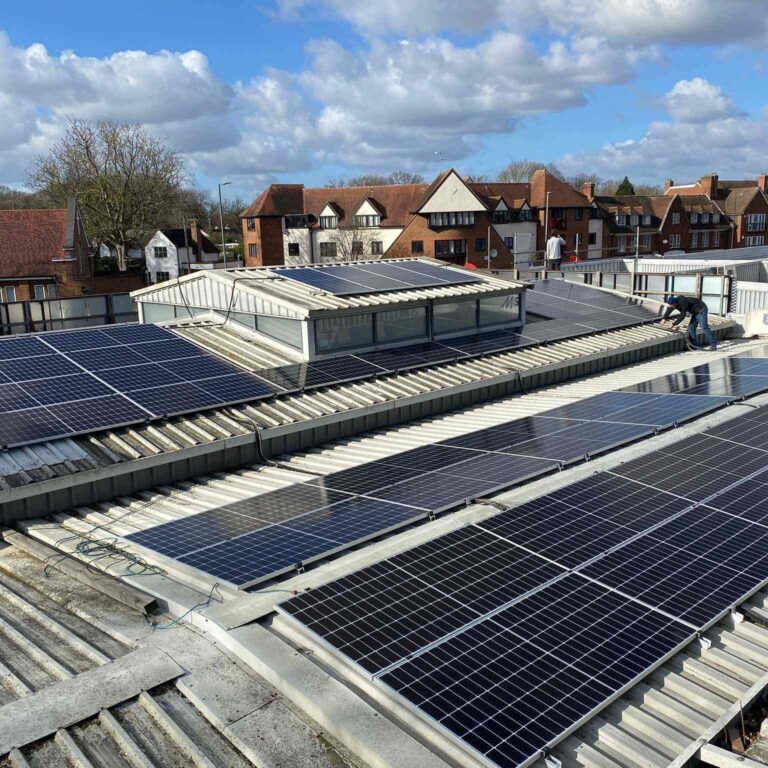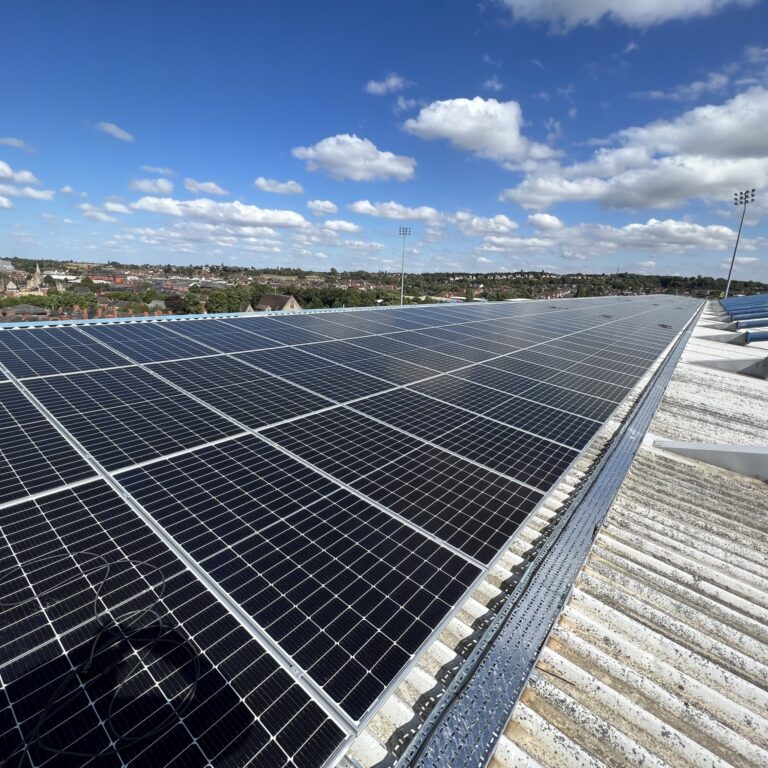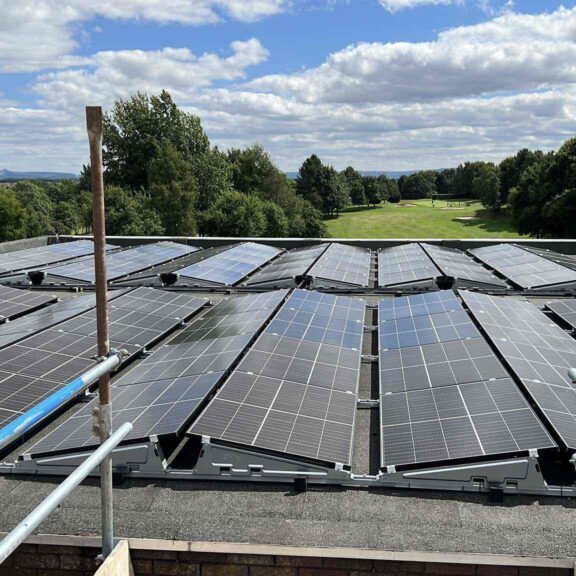With the increasing shift toward renewable energy solutions, solar car ports are gaining traction in commercial spaces as a versatile and efficient investment. These solar structures, installed over parking areas, provide dual benefits: generating solar energy and offering shaded parking for employees, clients, and guests. For businesses focused on sustainability, energy savings, and adding value to their property, solar car ports represent an excellent opportunity to meet these goals.
In this article, we will explore the benefits of solar car ports for commercial applications, how they work, the types of systems available, installation considerations, and how businesses can maximize their return on investment.
What are Solar Car Ports?
Solar car ports are elevated structures with solar panels installed on their canopies, allowing them to generate electricity while providing covered parking. Unlike rooftop solar, which is limited by roof space and structural limitations, solar car ports can cover vast parking lots, making them an ideal solution for commercial properties with ample parking space. These structures are particularly valuable in settings like shopping malls, corporate offices, hospitals, and airports, where they serve as both power generation and shade-providing assets.
By harnessing solar energy, these car ports help businesses offset a portion—or even all—of their electricity usage, reduce reliance on the grid, and enhance their sustainability profile. Solar car ports have seen widespread adoption in recent years, thanks to declining solar panel costs, government incentives, and a push toward eco-friendly corporate practices.
Benefits of Solar Car Ports for Commercial Use
- Reduced Energy Costs One of the main reasons commercial properties invest in solar car ports is to reduce their electricity costs. By generating solar energy onsite, businesses can reduce their reliance on utility-provided electricity, which typically results in significant long-term savings. This benefit is particularly valuable in regions with high electricity rates or frequent rate increases.
- Enhanced Property Value Solar car ports add tangible value to commercial properties. In addition to lowering operating costs, they represent an infrastructure improvement that appeals to tenants, employees, and clients. The addition of covered parking is also an attractive feature for visitors, providing shade and weather protection. This value addition can make a property more competitive and appealing in the commercial real estate market.
- Environmental and CSR Benefits Solar car ports align with corporate social responsibility (CSR) goals and environmental commitments. By adopting renewable energy, businesses reduce their carbon footprint, promoting a green brand image that appeals to environmentally-conscious clients and investors. This commitment to sustainability can also help businesses meet environmental certifications and comply with green building standards such as LEED (Leadership in Energy and Environmental Design).
- Support for Electric Vehicle (EV) Charging Solar car ports provide a convenient location for electric vehicle (EV) charging stations, which are increasingly popular among customers and employees alike. By pairing solar car ports with EV chargers, businesses can create a fully sustainable charging solution powered by renewable energy. This additional service can attract environmentally-aware clients and employees, positioning the company as a forward-thinking and sustainable brand.
- Tax Incentives and Depreciation Benefits Solar car ports are eligible for various financial incentives, including federal and state tax credits, accelerated depreciation, and rebates. In the U.S., the Investment Tax Credit (ITC) allows businesses to deduct up to 26% of the cost of solar installations, including solar car ports, from their federal taxes. Additionally, businesses can take advantage of accelerated depreciation through the Modified Accelerated Cost Recovery System (MACRS), allowing them to further reduce their tax liability.
Types of Solar Car Ports for Commercial Use
- Single-Canopy Car Ports Single-canopy solar car ports cover a single row of parking spaces. These systems are straightforward to install and ideal for businesses with limited parking areas or narrow lots. Despite their simplicity, single-canopy car ports still deliver significant energy generation, especially in sunny regions.
- Double-Canopy Car Ports Double-canopy car ports cover two rows of parking spaces under one structure, maximizing energy production and parking lot coverage. These installations are ideal for larger parking lots and can serve as a primary power source for commercial buildings with high energy demands.
- Customizable Tilt and Orientation Solar car ports can be customized with tilts and orientations optimized to capture maximum sunlight. For example, car ports with an adjustable tilt can enhance energy efficiency in regions with varying sunlight angles throughout the year. Some installations also feature tracking systems that follow the sun’s path, further boosting energy generation.
Installation Considerations for Solar Car Ports
- Location and Sunlight Availability The success of solar car ports depends largely on the availability of sunlight. For maximum energy generation, businesses should consider the orientation and placement of the car ports within the parking area, avoiding any nearby obstructions that could cast shadows on the panels. Ideally, car ports should face south (or the equivalent optimal direction in the region) to capture the most sunlight throughout the day.
- Structural Considerations Solar car ports are typically larger and heavier than standard carport structures, as they must support the weight of the solar panels, racking, and wiring. Therefore, choosing a reliable, experienced installer is critical for ensuring that the structure is safe and compliant with local building codes. Structural integrity is especially important in regions with heavy snowfall or strong winds, where reinforced designs may be required.
- Permitting and Regulations Permitting for solar car ports can be more complex than rooftop solar, as it involves more infrastructure. Local regulations and zoning laws vary, so it’s essential for businesses to work with experienced solar providers who can manage the permitting process and ensure the project meets all legal requirements.
- Maintenance and Monitoring Solar car ports require periodic maintenance, especially in dusty or snowy regions where panels may need cleaning to maintain efficiency. Monitoring systems can help by providing real-time data on system performance, making it easier to identify and address issues promptly. Many modern systems also offer automated alerts for maintenance needs, helping to ensure the solar car port consistently operates at peak performance.
Maximizing ROI on Solar Car Ports
- Take Advantage of Incentives To maximize the return on investment (ROI), businesses should leverage all available incentives and tax breaks, such as the federal ITC and MACRS depreciation. Some regions also offer state-level rebates and grants specifically for commercial solar installations, which can further reduce costs.
- Integrate EV Charging Stations Adding EV charging stations to solar car ports can create additional revenue streams for businesses. Some companies charge fees for EV charging, providing an extra source of income. Additionally, providing charging facilities can increase foot traffic from EV drivers, who may choose to shop or spend more time on-site while their vehicles charge.
- Explore Battery Storage Solutions Pairing solar car ports with energy storage solutions can enhance ROI by allowing businesses to store excess solar energy generated during the day and use it during peak hours. This can reduce demand charges and provide additional resilience in case of power outages. Energy storage can also enable the business to maintain power for EV chargers during peak demand times, maximizing convenience for users.
- Opt for High-Efficiency Panels The quality and efficiency of solar panels directly impact energy production and, by extension, ROI. High-efficiency panels, though more expensive initially, generate more electricity per square foot, optimizing the output of each car port. These panels are particularly beneficial in limited space scenarios where maximizing energy output is essential.
Case Study: The Impact of Solar Car Ports on a Commercial Property
For example, a corporate office in California implemented a solar car port system over its parking lot, offsetting approximately 50% of its annual electricity usage. By pairing the system with an EV charging station, the office not only reduced energy costs but also provided a new amenity for employees and clients. The company leveraged federal and state tax credits, bringing down the upfront costs, and now anticipates recouping the investment in under seven years. Furthermore, the solar car port has elevated the company’s reputation as an environmentally-conscious brand, attracting clients who value sustainability.
Conclusion: Are Solar Car Ports Right for Your Business?
Solar car ports represent a versatile and profitable solution for commercial properties looking to reduce energy costs, enhance property value, and strengthen their sustainability profile. While the initial investment may be significant, the long-term savings, incentives, and environmental benefits make solar car ports a valuable asset for businesses committed to renewable energy.
By optimizing the design, taking advantage of tax incentives, and integrating EV charging, commercial entities can maximize their ROI, positioning solar car ports as a wise, future-forward investment in a rapidly evolving energy landscape.



